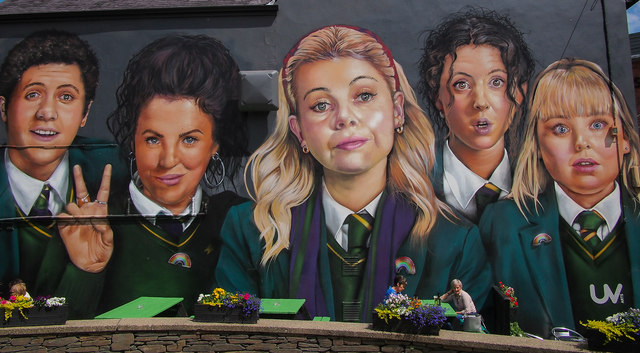Since its debut in 2018, Derry Girls has become an iconic contribution to Irish pop culture, even earning its own mural at the Badgers Bar and Restaurant at 18 Orchard Street, Derry. The comedic and wholesome teen sitcom, following the lives of five teenagers navigating the awkward challenges of adolescence against the backdrop of the late 90s Troubles in Northern Ireland, has captured the hearts and attention of many; even becoming the most watched TV Show in Northern Ireland since 2002.
The success of this show can mainly be attributed to its accuracy in portraying life in 90s Northern Ireland; balancing serious themes such as civil conflict, sectarianism, death and grief without losing its light-hearted comedy, sentimentality and realistic portrayal of imperfect, awkward and messy teens who are trying to find their identity and way in life.
For years we have been used to the glitz and glam of perfect teens on the screen. Popular teen dramas portray an unattainable standard of teens to us: they drive their flashy cars and waltz into school at 7am with impeccable outfits and makeup, they seem to have everything and more: looks, boyfriends, wealth and popularity. What makes Derry Girls so fresh and relatable is their realistic depiction of imperfect, quirky teenagers; they frequently embarrass themselves, get in trouble in school, have friendship fallouts and argue with family. They are unapologetically messy and flawed.
This realistic portrayal of working-class teenagers is not only amplified by the witty, endearing Irish humour and dialogue but also by the costume decisions; the messy school uniforms, the awkward 90s prom dresses and the repeated wear of the same outfits. This authenticity is executed perfectly by set costume designer, Cathy Prior, who made the decision to frequently have the characters re-wear the same clothes across the seasons, adding the perfect touch of realism in depicting teenage life.
But perhaps the most accurate detail of teenage life is the recurring theme of them missing important world events because of their own personal dramas. Amidst a world of bomb raids, civil conflict, ceasefires and visits from American presidents – they are too caught up in the trivial issues of adolescence. When the bridge is bombed they are caught up defending Orla from mockery, when the IRA ceasefire is announced they are busy squabbling with family, when the American president, Bill Clinton, comes to Derry, instead, James’ departure from the city takes precedence; because when you are a teenager, it is difficult to believe that there is a world outside that bubble of problems and situations you are experiencing.
Those trivial problems of prom dresses, detentions and friendship fallouts can feel like the whole world, and significant international events often just feel like background noise. It’s a clever reminder that, while politics shapes the world around them, teenagers are still teenagers: self-absorbed, emotionally impulsive, and hilariously out of touch.
Lisa McGee’s decision to end the series as the five teens get older represents their uncertainty about growth and change. We don’t know the girls and James’ future or what careers they’ll have or what they will achieve in life, because they are not sure either: they are too busy trying to come to terms with the sudden thrust into adulthood and wishing they could stay in that bubble of being teenagers forever.
In a world of oversaturated teen shows that strive for aesthetic perfection, Derry Girls dares to be real — and that’s what makes it unforgettable. It is a love letter to the chaos of growing up and appreciating the imperfect awkwardness of your teenage years.

This article is beautifully put together, such an enjoyable read.